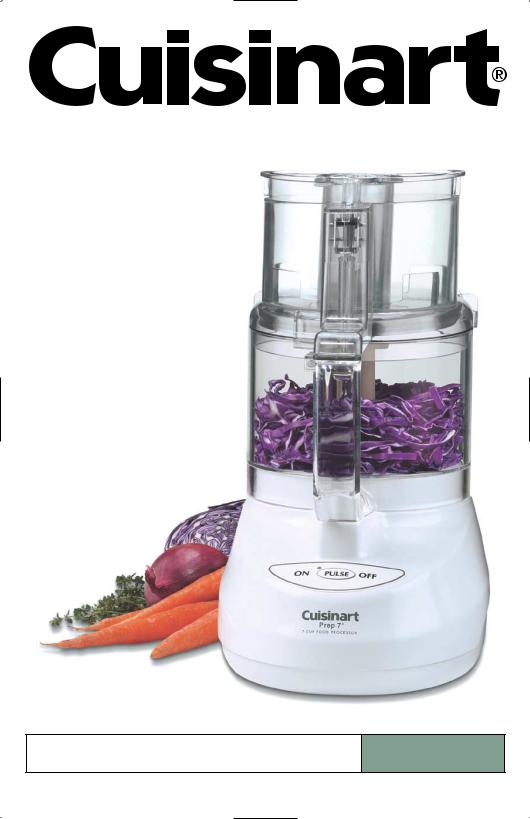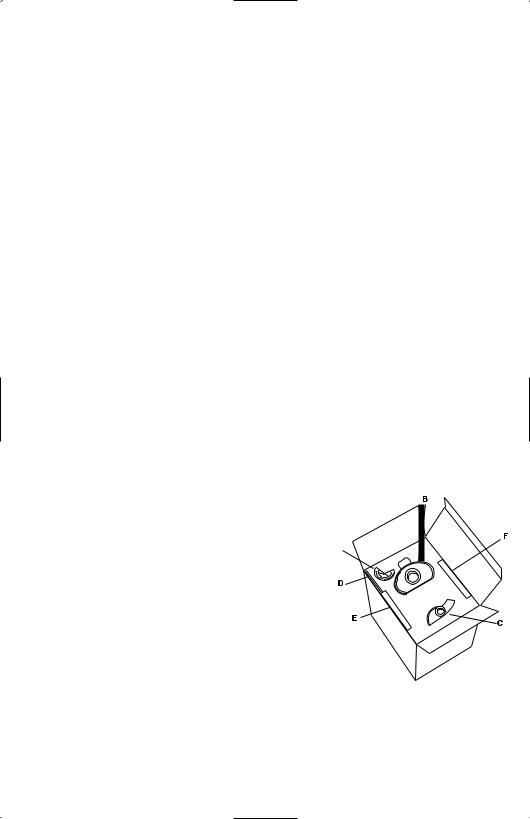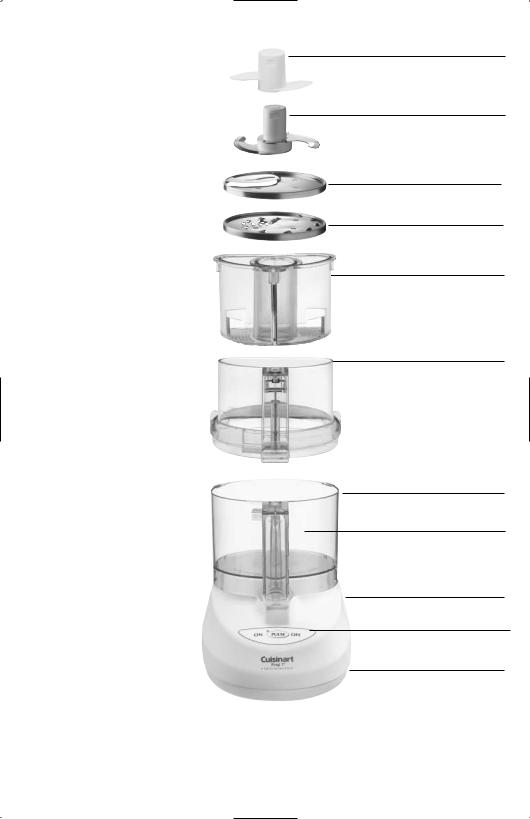Cuisinart DLC-2007N User Manual

INSTRUCTION AND RECIPE BOOKLET
For your safety and continued enjoyment of this product, always read the instruction book carefully before using.

Recommended work bowl capacity for various foods
FOOD |
CAPACITY |
Chopped Fruits |
7 cups processed food |
and Vegetables |
|
Chopped or Puréed |
1-1/4 pounds meat, cut in 1 inch or smaller cubes, chilled |
Meat, Poultry, |
|
Fish or Seafood |
|
Bread Dough |
4 cups flour (32 ounces), yielding two 1-pound loaves |
Pizza Dough |
3 cups flour (26 ounces), yielding 3 12-inch pizzas |
Nuts for Nut Butters |
2-3 cups (10-15 ounces) |
Sliced or Shredded |
7 cups (total processed volume varies by food) |
Fruit, Cheese, |
|
or Vegetables |
|
Cake Batter |
batter for three 8-inch layers |
Cookie Dough |
dough for about 50 cookies (2 pounds) |
Thin Liquids |
2 cups |
(such as custard |
|
for quiche or |
|
cheesecake batter) |
|
Thick Liquids |
5 cups |
Puréed Cooked |
5 cups cooked yielding approximately |
Fruits and Vegetables |
3-1/2 cups thick purée |
Puréed Soft |
5 cups fresh yielding approximately |
Fresh Fruits (berries, |
3-1/2 cups thick purée |
kiwis, peaches, etc.) |
|
1

IMPORTANT UNPACKING INSTRUCTIONS
This package contains a Cuisinart® Premier Series 7-Cup Food Processor, and the standard parts for it:
Work bowl, work bowl cover, large and small pushers, dough blade, metal chopping/mixing blade, slicing disc, shredding disc, detachable disc stem for discs, spatula, how-to video and recipe/instruction book.
CAUTION:
THE CUTTING TOOLS HAVE VERY SHARP EDGES. To avoid injury when unpacking the parts, please follow these instructions.
1.Place the box on a low table or on the floor next to the kitchen counter or table where you intend to keep the food processor. Be sure the box is right side up.
2.Remove the cardboard insert. You will see a rectangular block of plastic foam that holds the processor parts, each fitted into a cavity in the foam.
3.The Detachable Disc Stem for the discs (A) sits in a cavity in one corner of the foam block. Remove this first.
4.The Pusher Assembly, with large and small pushers, (B) sits in the adjacent cavity. Remove this next.
5.The Dough Blade (C) rests in a cavity on the opposite side of the foam block. Remove it from the foam.
6.The plastic Spatula (D) is on one long side of the foam block. Remove it next.
7.The Slicing Disc (E) is on the edge of one of the long sides of the foam block; the Shredding Disc (F) is on the other side. Slide them out WITH GREAT CARE; THE BLADES ARE VERY SHARP.
8.Lift out the foam block.
9.Remove the instruction/recipe book.
10.Lift out the video from its space in the cardboard frame on one side of the box. Then lift out the cardboard frame.
11.The housing base with work bowl, metal blade and cover are at the bottom of the box. The metal blade is loose in the work bowl beneath a foam insert. Do not reach into feed tube. Do not turn over work bowl without first removing metal blade.  Remove work bowl cover by turning it clockwise and lifting.
Remove work bowl cover by turning it clockwise and lifting.
12.Remove the base and bowl together by grasping the plastic bowl at the top with both hands and lifting the bowl straight up. Do not rotate the bowl clockwise on the base. This will cause the bowl to separate from the base.
13.Place the food processor on the counter or table. Remove foam
cylinder insert from top of metal chopping blade. Read the instructions thoroughly before using the machine.
14.Save the shipping cartons and plastic foam blocks. You will find them very useful if you need to repack the processor for moving or other shipment.
Please watch the enclosed how-to video before using the food processor.
NOTE: Remember to return your completed product registration card with all information carefully filled out.
WHEN
REMOVING BLADE:
CAREFULLY REMOVE THE METAL BLADE BY GRASPING THE CENTER WHITE HUB AND LIFTING IT STRAIGHT UP. NEVER TOUCH THE BLADES, AS THEY ARE RAZOR SHARP.
2

TABLE OF CONTENTS
Recommended Capacities . . . . . . . . . . 1 Unpacking Instructions. . . . . . . . . . . . . 2 Important Safeguards . . . . . . . . . . . . . . 4 Introduction . . . . . . . . . . . . . . . . . . . . . . 5 Machine Includes. . . . . . . . . . . . . . . . . . 6 Assembly Instructions . . . . . . . . . . . . . 6 Machine Functions . . . . . . . . . . . . . . . . 7 Operating Instructions . . . . . . . . . . . . . 7 Chopping, Puréeing & Mixing
with Metal Blade . . . . . . . . . . . . . . . . . . 8
Chop Raw Fruits and Vegetables . . . . . . 8 Purée Fruits and Cooked Vegetables . . . 8 To Dislodge Food . . . . . . . . . . . . . . . . . . 8 Chop Hard Food . . . . . . . . . . . . . . . . . . . 8 Chop Fresh Herbs . . . . . . . . . . . . . . . . . . 8 Chop Peel from Citrus Fruit . . . . . . . . . . . 8 Chop Sticky Fruit Like Dates . . . . . . . . . . 8 Chop Meat, Poultry and Fish. . . . . . . . . . 9 Purée Meat, Poultry and Fish . . . . . . . . . 9 Chop Nuts . . . . . . . . . . . . . . . . . . . . . . . . 9 Make Peanut Butter. . . . . . . . . . . . . . . . . 9 Make Flavored Butters,
Spreads and Dips . . . . . . . . . . . . . . . . . . 9 Make Mayonnaise . . . . . . . . . . . . . . . . . . 9 Beat Egg Whites . . . . . . . . . . . . . . . . . . 10 Whip Cream. . . . . . . . . . . . . . . . . . . . . . 10 Make Crumbs and Crumb Crusts . . . . . 10 Make Pastry. . . . . . . . . . . . . . . . . . . . . . 10 Make Quick Breads and Cakes. . . . . . . 10
Preparing Food For Slicing
and Shredding . . . . . . . . . . . . . . . . . . . 11
Round Fruits and Vegetables . . . . . . . . 11 Whole Peppers . . . . . . . . . . . . . . . . . . . 11 Large Fruits Like Pineapple . . . . . . . . . . 11 Cabbage and Iceberg Lettuce . . . . . . . . 11 Packing Feed Tube for
Desired Results . . . . . . . . . . . . . . . . . . . 11
Practicing Slicing and Shredding. . . . 12 Removing Sliced or Shredded Foods 12 Slicing and Shredding Techniques. . . 12
Small, Round Fruits and Vegetables . . . 12 Long Fruits and Vegetables. . . . . . . . . . 12 Small Amounts of Food . . . . . . . . . . . . . 13 French-Cut Green Beans . . . . . . . . . . . 12 Matchsticks or Julienne Strips . . . . . . . . 12
Slicing Meat and Poultry. . . . . . . . . . . 13
Cooked Meat and Poultry . . . . . . . . . . . 13 Uncooked Meat and Poultry . . . . . . . . . 13 Slicing Sausages . . . . . . . . . . . . . . . . . . 13
Slicing and Shredding Cheese . . . . . . 13 Kneading Yeast Dough
with Dough Blade . . . . . . . . . . . . . . . . 14
Machine Capacity . . . . . . . . . . . . . . . . . 14 Using the Right Blade . . . . . . . . . . . . . . 14 Measuring the Flour. . . . . . . . . . . . . . . . 14 Proofing the Yeast . . . . . . . . . . . . . . . . 14 Processing Dry Ingredients . . . . . . . . . . 14 Adding Liquids . . . . . . . . . . . . . . . . . . . . 15 Kneading Bread Dough . . . . . . . . . . . . . 15 Kneading Sweet Dough. . . . . . . . . . . . . 15 Rising. . . . . . . . . . . . . . . . . . . . . . . . . . . 15 Shaping, Finishing and Baking . . . . . . . 15 Making Consecutive Batches . . . . . . . . 15
Bread Dough
Problems and Solutions . . . . . . . . . . . 15 Sweet Dough
Problems and Solutions . . . . . . . . . . . 16 Cleaning and Storing. . . . . . . . . . . . . . 17 For Your Safety . . . . . . . . . . . . . . . . . . 18 Technical Data . . . . . . . . . . . . . . . . . . . 18 Warranty . . . . . . . . . . . . . . . . . . . . . . . . 18 Recipes . . . . . . . . . . . . . . . . . . . . . . . . . 20
3

Carefully read all instructions before using this appliance.
IMPORTANT SAFEGUARDS
Always follow these safety precautions when using this appliance.
Getting Ready
1.Read all instructions.
2.Blades are sharp.
Handle them carefully.
3.Always unplug from outlet when not in use, before putting on or taking off parts, before removing food and before cleaning. To unplug, grasp plug and pull from electrical outlet. Never pull cord.
4.Do not use outdoors.
5.Do not let cord hang over edge of table or counter, or touch hot surfaces.
6.Do not operate any appliance with damaged cord or plug, or after appliance has been dropped or damaged
in any way. Return appliance to the nearest authorized service facility for examination, repair, or electrical or mechanical adjustment.
Operation
1.Keep hands as well as spatulas and other utensils away from moving blades or discs
while processing food, to prevent the possibility of severe personal injury or damage to food processor. A plastic scraper may be used, but only when the food processor motor is stopped.
2.Avoid contact with moving parts. Never push food down into feed tube by hand when slicing or shredding. Always use pusher.
3.Make sure motor has completely stopped before removing cover. (If machine does not stop within 4 seconds after you remove the pusher assembly, call 1-800-762-0190 for assistance. Do not use the machine.)
4.Never store any blade or disc on motor shaft. To reduce the risk of injury, no blade or disc should be placed on the shaft except when the bowl
is properly locked in place and the processor is in use. Store blades and discs as you would sharp knives, out of reach of children.
5.Be sure cover and feed tube are securely locked in place before operating food processor.
6.Never try to override or tamper with cover interlock mechanism.
Cleaning
To protect against risk of electrical shock, do not put base in water or other liquid.
General
1.Close supervision is necessary when any appliance is used by or near children.
2.Do not operate this, or any other motor-driven appliance, while under the influence of alcohol or other substances that affect your reaction time or perception.
3.This food processor is UL listed for household use. Use it only for food preparation as described in the accompanying recipe and instruction book.
4.The use of attachments not recommended or sold by Cuisinart may cause fire, electrical shock or personal injury, or damage to your
food processor.
5.To avoid possible malfunction of
work bowl switch, never store processor with pusher assembly in locked position.
6.Maximum rating of 5.2 amperes is based on attachment that draws greatest current. Other recommended attachments may draw
significantly less current.
NOTICE: This appliance has a polarized plug (one blade is wider than the other). As a safety feature, this plug will fit in a polarized outlet only one way. If the plug does not fit fully in the outlet, reverse the plug. If it still does not fit, contact a qualified electrician. Do not attempt to defeat this safety feature.
SAVE THESE INSTRUCTIONS
FOR HOUSEHOLD USE ONLY
4

INTRODUCTION
Congratulations on your purchase of a Cuisinart® Premier Series 7-Cup Food Processor. This
product is the ultimate food preparation tool, and it comes from the originator of the American food processor, Cuisinart.
The Cuisinart® Premier Series 7-Cup Food Processor has all the elements of quality that Cuisinart is known for, including a powerful motor, the largest feed tube, and the longest warranty in the industry.
It also introduces a new feature that will set the industry standard:
•The Cuisinart® Supreme® Wide Mouth Feed Tube, which is more than two and a half times the size of any other available. Perfect for slicing whole fruits and vegetables.
This feature, plus the ability to use all of your existing Cuisinart specialty blades and discs, makes the Premier Series 7-Cup the select choice in food processors.
Dough Blade
Chopping/Mixing
Blade
4mm Slicing Disc
Medium
Shredding Disc
Pusher Assembly
Cover with Cuisinart® Supreme® Wide Mouth Feed Tube
7-cup Work Bowl
Shaft (not shown)
Housing Base
Touchpad Control Panel
Cord Wrap (not shown)
5

THE MACHINE
INCLUDES:
1.Housing base with a vertically projecting shaft and convenient touchpad control panel.
2.7-cup work bowl.
3.Cover with extra large feed tube.
4.Pusher assembly that slides inside the feed tube.
5.Dough blade.
6.Sharp metal chopping/mixing blade.
7.Serrated slicing disc.
8.Shredding disc.
9.Detachable stem
for discs (not shown).
10.Plastic spatula (not shown).
The metal chopping blade chops raw and cooked fruits, vegetables, meat, fish and cheese to the exact consistency you want, from coarse to fine, even to a purée. It chops nuts, makes nut butters, mayonnaise and sauces, and mixes tender, flaky pastry. The metal chopping blade also mixes cakes, frostings, cookies,
quick breads, muffins, and biscuits.
The slicing disc makes beautiful whole slices without torn edges.
It slices whole fruits and vegetables, cooked meat, semi-frozen raw meat and loaves of bread.
The shredding disc processes most firm and
hard cheeses into long, attractive shreds. It also shreds vegetables like potatoes, carrots and zucchini, and processes nuts and chocolate to a grated texture.
The detachable stem fits both discs, making disc storage compact in limited space.
The pusher assembly has two parts.
1.A small, removable, clear pusher that fits into a small center-located feed tube. This tube is for narrow food like carrots, for adding liquid, and for continuous feeding of small food like garlic.
2.A large pusher that fits into the Cuisinart® Supreme® feed tube opening and moves freely within it.
Upon contact, the large pusher meets an activating rod in the center of the work bowl handle, permitting the motor to start.
ASSEMBLY INSTRUCTIONS:
Blade Operation
1.Plug in the housing base and place the work bowl on top, with the work bowl handle just to the left of center. Turn the work bowl counterclockwise to lock it onto the housing base.
2.CAREFULLY lift and place the chosen blade over the work bowl center shaft. Line up the markings on the blade hub with the motor shaft.
Blade should fit snugly and rest on the bottom of the work bowl.
3.Add desired ingredients to work bowl.
4.Place work bowl cover onto work bowl, with the handle area just to the left of center. Turn counterclockwise to lock onto work bowl.
5.Align pusher assembly and activating rod with the feed tube opening on the work bowl cover and slide the activating rod down to the bottom.
6.You are now ready to operate the machine.
Disc Operation
1.Plug in the housing base and place the work bowl on top, with the work bowl handle just to the left of center. Turn the work bowl counterclockwise to lock it onto the housing base.
2.Choose desired disc and place underside-up on tabletop. Pick up detachable disc stem and align it with the raised plastic crescent on the disc underside. The raised ‘lock’ indicator on the left corner of the stem should be to the left of the mounting plate on disc.
3.Turn the stem to the right, so the locking tabs are covered by the metal supports and a ‘click’ locks the stem in place.
4.With the stem facing down, place the assembly over the center hub. It should fit snugly and
rest on the bottom of the
work bowl. |
6 |

5.Place work bowl cover onto work bowl, with the handle area just to the left of center. Turn counterclockwise to lock onto work bowl.
6.Align pusher with the feed tube opening on the work bowl cover and slide the activating rod down to the bottom.
7.Use the cord wrap on the housing base underside to add or remove cord.
8.You are now ready to operate the machine.
THE MACHINE
FUNCTIONS:
PULSE
1.With the machine properly assembled and engaged, and ingredients in the work bowl, press the PULSE button repeatedly as needed.
ON (Continuous)
1.Properly assemble and engage the machine.
2.To add ingredients through the feed tube, remove the pusher and fill the feed tube as directed (see preparing for slicing or shredding).
3.Engage the pusher and press the ON button. The button light will turn on and the motor will start.
4.Press the pusher firmly down until all ingredients have passed into the work bowl. Remove
the pusher and refill ingredients as needed.
When you engage the pusher again, the unit will automatically
turn ON.
5.Press the OFF button when finished.
OPERATING INSTRUCTIONS:
Try chopping some practice foods, such as a zucchini or potato, before you process food to eat. First, cut the ingredients into 1-inch pieces.
•Place the work bowl over the center stem, with the handle area just to the left of center. Turn counterclockwise to lock in place.
•Insert the metal chopping blade and put ingredient pieces in the work bowl.
Put on the cover and turn counterclockwise to lock onto work bowl. Align the pusher and the pusher’s activating rod with the corresponding openings on the feed tube, and push all the way down.
•Press and release the PULSE button two or three times. Each time the blade stops, let the pieces drop to the bottom of the bowl before you pulse again. This puts them in the path of the blade each time the motor starts.
•Using the pulse/chopping technique, you get an even chop without overprocessing. Check the texture frequently
by looking through the cover. If you want a finer chop, press and release the PULSE button until you achieve the desired texture.
Onions and other food with a high water content will quickly end up as a purée, unless examined through the work bowl after each pulse to make sure they are not overprocessed.
Try chopping other food like meat for hamburger or sausage. Then make mayonnaise, pastry or bread, as described in the following sections. To obtain consistent results:
Be sure all the pieces you add to the bowl are about the same size.
Be sure the amount you process is no larger than recommended on the inside cover of this booklet.
Before you do anything, wait for the blade to stop spinning. Once it does, turn the cover clockwise to unlock, and remove by lifting it off.
Remove the bowl from the base of the machine before removing the blade. This creates a seal to prevent food from leaking. Turn the bowl clockwise to unlock from the base, and lift straight up to remove.
To prevent the blade from falling from the work bowl onto your hand when emptying the work bowl, use one
of the following methods.
Be sure your hands are dry.
7

Grab the blade hub, and remove the metal blade before tilting the bowl, using a spatula to scrape off any food. Then carefully lift the blade out of the work bowl. Or insert your finger through the hole in the bottom of the work bowl, gripping the blade from the bottom, and grip the outside of the work bowl with your thumb. Or hold the blade in place with your finger or spatula while pouring out food.
TECHNIQUES FOR CHOPPING AND PURÉEING WITH THE METAL BLADE
To chop raw fruits and vegetables:
First cut the food into 1-inch (2.5cm) pieces. You get a more even chop when all pieces are about the same size.
Put no more than the recommended amount of food into the work bowl (see table inside front cover). Lock the cover in place. Press the PULSE button at the rate of 1 second on, 1 second off, until the food is coarsely chopped. For more finely chopped results, hold the PULSE button, letting the machine run continuously until the desired consistency has been
reached. Check frequently to avoid overprocessing. Use the spatula to scrape down the sides of the work bowl if necessary.
To purée fruits and cooked vegetables:
First, cut the food into 1-inch (2.5cm) pieces.
You get a smoother purée faster when all pieces are about equal in size.
Put no more than the recommended amount of food in the work bowl (see table inside front cover). Lock the cover in place. PULSE to chop coarsely, then press the ON button and process continuously until food is puréed. (NOTE: Cooked potatoes are an exception to this procedure. They develop a gluey texture when processed with the
metal blade.)
When making soup, you will want to purée vegetables that have been cooked in liquid. Don’t add the liquid to the work bowl, just the cooked vegetables; remove vegetables with a slotted spoon. They will purée faster and smoother without liquid. Then add just enough liquid to make the purée pourable, return to the soup liquid and stir to combine.
To dislodge food:
Occasionally, a piece of food may become wedged between the blade and the work bowl. If this happens, unplug the machine, remove the cover, lift the blade
out carefully and remove the wedged piece. Empty the bowl, reinsert the blade
and lock the cover and pusher into place. Press the ON button and drop the food pieces through the small feed tube opening while the machine is running. After adding a cupful this way, add the remaining food to the
bowl and process in the usual manner.
To chop hard foods:
To chop hard food like garlic and hard cheese, assemble the unit, remove the small pusher, press the ON button and drop the food through the small
feed tube while the machine is running.
Small foods like garlic can be dropped in whole. Large foods like hard cheese should be cut into 1-inch (2.5cm) pieces. This method of processing minces garlic, shallots and onions. Hard cheese and coconut will have the same texture as if they had been hand grated.
IMPORTANT: Never try to process cheese that is too hard to cut with a knife.
You may damage the blade or the machine.
To chop parsley and other fresh herbs:
The herbs, the work bowl and the metal chopping blade must all be thoroughly clean and dry. Remove stems from herbs. Add leaves to bowl and process, using the PULSE button until chopped as fine as desired. The more herbs you chop at a time, the finer chop you can obtain. If completely dry when chopped, parsley and other herbs will keep for at least 4-5 days, stored in an airtight bag in the refrigerator. They may be frozen for months, stored in an airtight container or bag.
To chop peel from citrus fruit or to chop sticky fruit like dates or raisins:
For citrus, remove only the peel with a vegetable peeler, not the white pith which is bitter tasting.
8

Cut the peel into lengths of 2 inches (5cm) or less and process with 1/2 cup
(125 ml) of granulated sugar until finely chopped. This may take 2 minutes
or longer.
For sticky fruit like dates, raisins, prunes and candied fruit, first freeze the fruit for about 10 minutes. Add some of the flour called for in the recipe to the fruit. Use no more than 1 cup (250 ml)
of flour for each cup of fruit.
To chop meat, poultry, fish and seafood:
The food should be very cold, but not frozen. Cut
it into 1-inch (2.5cm) pieces to ensure an even chop. Using the ON button, process no more than the recommended amount at one time (see table inside front cover). Press the PULSE button 3 or 4 times at a rate of 1 second on, 1 second off. If the food is not chopped fine enough, let the processor run continuously for a few seconds. Check the texture often to avoid overprocessing. Use a spatula to scrape food
from the sides of the bowl as necessary.
To purée meat, poultry, fish and seafood:
Prepare the food as described above. Press the PULSE button until evenly chopped, then process continuously to the desired texture. Scrape the bowl with a spatula
as needed.
Leave the purée in the work bowl and add eggs, cream and seasonings as called for by the recipe. Process to combine thoroughly.
9
Remember, you control texture by the length of time you process. By varying the processing time, you can get a range of textures suitable for hamburgers, hash, stuffed peppers, or smooth mousses.
To chop nuts:
Chop no more than the recommended amount at one time. Press and release the PULSE button and check frequently to avoid nuts clumping together in a nut butter. When a recipe calls for flour or sugar, add some to the nuts before you chop, about 1/2 cup for each cup of nuts. This allows you to chop the nuts as fine as you want without turning them into a nut butter. You can also chop nuts with a shredding or slicing disc. The optional Fine Shredding Disc is particularly good.
To make peanut butter and other nut butters:
Process up to the recommended amount of nuts. Using the ON
button, let the machine run continuously.
After 1-1/2 to 2 minutes, the ground nuts will form a ball that will gradually smooth out. Scrape the sides of the bowl and continue processing until drops of oil are visible. Taste for consistency. The longer you process, the softer the butter. For chunk style, add a handful of nuts just after the ball of nut butter begins to smooth out. To make cashew butter, add a little bland vegetable oil. Processor nut butters contain no preservatives.
Store in refrigerator to keep from separating.
To make flavored butters, spreads and dips:
Cut room temperature butter into tablespoon size pieces. Finely chop flavoring ingredients first, such as anchovies, cheese, herbs, etc. Be sure work bowl is clean and dry. Add small hard ingredients like garlic and hard cheese through the feed tube while machine is running. Next, add the butter and process using the ON button, until smooth. Add any liquid ingredients last, while the processor is running, and process just long enough to blend. Process ingredients for spreads and dips the same way. They should be at room temperature and cut into 1-inch (2.5cm) cubes, or added by tablespoonfuls.
To make mayonnaise:
You can make foolproof homemade mayonnaise with your Premier Series 7- cup Food Processor. The work bowl and metal blade must be clean and dry.
Foods prepared with raw eggs may contain salmonella or other potentially harmful bacteria. Because egg yolks are a fine growth medium for bacteria, we recommend that you cook them for use in mayonnaise, Hollandaise sauce, Caesar salad dressing, chilled soufflés, chilled chiffons, mousses and other recipes calling for raw egg yolks. For mayonnaise, we recommend using either the “cooked egg” mayonnaise on page 29, or using the following method with pasteurized liquid eggs.

For a “one egg” batch of basic mayonnaise made with pasteurized liquid eggs, place 1/4 cup pasteurized liquid eggs, 2 tablespoons wine vinegar or lemon juice, 1 teaspoon dry mustard, 1/2 teaspoon kosher salt and a pinch of ground white pepper in the work bowl. With the machine running, add 1/2 cup of vegetable oil to the small pusher and allow to slowly drip into the mixture while processing. After all the oil has dripped through, add another 1/2 cup of vegetable oil to the small pusher and allow to drip through. The mixture will form a thick emulsion. For variation, you may experiment with using flavored vinegars, adding chopped fresh herbs, dry herbs, or roasted garlic to taste. To make your mayonnaise a little lighter, add some welldrained plain fat free yogurt to taste.
To beat egg whites:
The work bowl must be absolutely clean. Add 3
or more egg whites (up to 6 large egg whites) and press the ON button. Add about 1 teaspoon of lemon juice or vinegar for every egg white. Vinegar makes stiffer whites; its flavor is hardly detectable in cakes or soufflés. Continue processing until the egg whites hold their shape, about 1-1/2 to 2-1/2 minutes.
To whip cream:
Processor whipped cream holds its shape very well. It is good for decoration or as a topping; however, it will not whip to the light, fluffy consistency obtained by
methods that beat in more air. Chill the cream well before starting. Process continuously using the ON button, until it begins to thicken. Then add sugar as desired and continue processing, watching carefully for the desired consistency.
For consistently reliable results, add 2 tablespoons (30 ml) of nonfat dry milk for every cup of cream before whipping.
To make crumbs and crumb crusts:
Cut or break bread, crackers or cookies into 1-inch pieces and place in work bowl. Press the ON button and process continuously until pieces reach the desired texture. For seasoned crumbs, chop parsley or other fresh herbs with the crumbs. For buttered crumbs, process until the dry crumbs are of the desired texture, then dribble melted butter through the small feed tube opening while the machine is running. For crumb crusts, process crackers or cookies as described above. Add sugar, spices and butter, and cut into pieces as specified by your recipe. Process until well combined.
To make pastry:
Combine unbleached all-purpose flour, salt and pieces of very cold butter in the work bowl. Process to the consistency of cornmeal. Sprinkle evenly with the minimum amount of cold liquid in the recipe. PULSE 5 or 6 times. The dough should begin to hold
together when pressed. If it is still dry and crumbly, add more water – 1 teaspoon at a time – until the dough holds together easily. Do not let the dough form a ball in the processor or it will be overworked and tough.
Form into a round disc, one inch thick, and wrap in plastic wrap. Refrigerate for 1 hour before using, or double wrap and freeze for later use.
To make quick breads and cakes that use baking powder and/or soda:
The most important rule for success is not to overmix after adding the flour. The ingredients for these soft doughs should be cold, except butter. If
the recipe calls for chopped ingredients like lemon peel or nuts, chop them first while the work bowl is clean and dry, then set aside until needed.
Put dry ingredients like flour, salt and leavening in the work bowl and process with the metal blade for
5 seconds to mix. Remove and reserve the dry ingredients.
Add the eggs and sugar
to the work bowl and, using the ON button, process to mix, letting the machine run about 1 minute. Next, add butter. Cut into 1-inch pieces at room temperature. Run machine continuously for a minute, until the butter is thoroughly mixed with the sugar and eggs. Then add flavoring and liquid – vanilla, spices, cocoa, etc. Process until mixed. Add the dry ingredients to the work bowl.
10

Process by pulsing, inspecting after each pulse. Stop pulsing as soon as the dry ingredients have almost disappeared into the batter. Overprocessing will cause quick breads and cakes to be tough. (If your recipe calls for ingredients that are to be coarsely chopped – like raisins or nuts – add them last with the mixed dry ingredients.)
To make cake mix:
Your food processor work bowl is large enough for the preparation of an 18.5- ounce packaged cake mix.
Insert the metal blade and add the cake mix to the work bowl. Press the ON button and while the machine is running, add the eggs and liquid through the small feed tube and process for 5 seconds.
Scrape down the sides of the work bowl and
process 1 minute more for maximum volume. Do not remove the metal blade.
Insert a finger into the underside of the blade from the bottom of the work bowl to hold the blade in place while emptying the batter.
Tip:
After emptying cake batter or puréed soup from the work bowl, replace the bowl on the motor base and PULSE once. Centrifugal force will spin the batter off the blade onto the sides of the work bowl. Remove the blade, and use the spatula to scrape any remaining batter from the bowl.
PREPARING FOOD FOR SLICING AND SHREDDING
For disc assembly instructions, refer to Assembly Instructions.
Round fruits and vegetables:
Before processing onions, apples and other large, round fruits and vegetables, cut the bottom ends flat to make the food lie stable on the disc.
Place the food in the feed tube, flat side down, as far left as possible, to prevent it from tilting when being processed.
Choose fruits that are firm and not too ripe. Remove large hard pits and seeds from fruits before processing. Seeds from citrus fruits need not be removed. Remove the rind before slicing or shredding, if desired.
Whole peppers are an exception:
Remove the stem and cut the stem end flat. Remove the core and scoop out the seeds. Leave the end opposite the stem whole, to keep the structure stiff. This ensures round, even slices.
Large fruits like pineapple:
Cut the ends flat, cut in half, and either core or remove the seeds. If necessary, cut the halves into smaller pieces to fit the feed tube.
Cabbage and iceberg lettuce:
Turn the head on its side and slice off the top and bottom, leaving a center section about 3 inches (8cm) deep. Remove the core, then cut in wedges to fit the feed tube. Remove the core from the bottom and top pieces and cut into wedges to fit into the feed tube.
The optional 2mm and 1mm Slicing Discs are excellent for slicing cabbage for coleslaw.
If the fruit or vegetable doesn’t fit, try inserting it from the bottom of the feed tube, where the opening is slightly larger.
Pack the feed tube for desired results.
For long slices or shreds, cut the food in feed tube widths and pack the pieces horizontally.
For small, round slices or short shreds from carrots, zucchini and other long vegetables, cut in feed tube heights and pack tightly upright.
Food should fit snugly, but not so tightly that it prevents the pusher from moving.
When slicing or shredding, always use the pusher.
Never put your fingers or a spatula into the feed tube.
Never push down hard on the pusher. Use light pressure for soft fruits and vegetables like bananas, mushrooms, strawberries and tomatoes, and for all cheese. Use medium pressure for most food:
11

apples, celery, citrus fruit, potatoes and zucchini. Use firm pressure for hard vegetables like carrots and yams.
PRACTICING
SLICING AND
SHREDDING
1.Insert a slicing or shredding disc, put the cover on the work bowl and insert the food in the feed tube.
2.Slide the pusher into place, and apply
pressure to the pusher while pressing down the PULSE button. Release the button as soon
as the food is sliced or shredded.
3.You can load the feed tube repeatedly without removing work bowl cover.
Simply grasp the pusher and lift up. The pusher assembly will come off easily, leaving the cover and feed tube in place. Your other hand is free to reload the feed tube, and you do not need to re-press the ON button if it was previously selected.
REMOVING
SLICED OR SHREDDED FOOD
Before you do anything, wait for the disc to stop spinning. When it does, unplug the unit, then hold the work bowl handle and turn it clockwise. Then lift; the work bowl and cover will come off together. Turn cover clockwise to unlock from work bowl.
Lift, remove, invert and place on counter space.
Remove the slicing or shredding disc.
Place two fingers under each side of the disc and lift it straight up. Place the disc on top of the inverted work bowl cover to minimize drips and spills.
TECHNIQUES FOR SLICING AND SHREDDING
Small, round fruits and vegetables:
For large berries, radishes and mushrooms, trim the bottom ends flat with a knife. Insert the food through the feed tube, standing each piece on a flat end. You can fill the tube to about 1 inch (2.5cm) from the top.
The bottom layer gives you perfect slices for garnish.
If you want all the slices to be perfect, it’s best to process one layer at a time.
Long fruits
and vegetables:
Trim foods like bananas, celery and zucchini by cutting them into pieces slightly shorter than the feed tube. Cut both ends flat. (Use a ruler as a guide, or the pusher assembly.)
Fill the feed tube with the pieces, standing them vertically and adding enough pieces so they are solidly packed and cannot tilt sideways as they are sliced or shredded.
Small amounts of food:
Use the small feed tube and the small pusher. Remove the small pusher from the pusher assembly. Place the pusher assembly onto the
feed tube and press the sleeve all the way down.
Cut the food in lengths slightly shorter than the feed tube. If slicing one or two long, thin vegetables like carrots, push them to the far left. If you are slicing a few vegetables that are wide at one end and narrow at the other (carrots, celery or scallions) cut them in half and pack in pairs, alternating one wide end up, one narrow end up.
French-cut green beans:
Trim fresh green beans to feed tube widths. Stack in the feed tube horizontally to about one inch from the top. Use the slicing disc, apply light pressure to the pusher and press the PULSE button until beans are sliced.
To make long, horizontal slices of raw zucchini
or carrots, use the same procedure.
Matchsticks or julienne strips:
Process the food twice – ‘double slice’ it. Insert large fruits or vegetables (potatoes, turnips, zucchini, apples) in the feed tube. Cut pieces to fit the feed tube horizontally from end to end. Apply pressure to the pusher while pressing the PULSE button until the food is sliced. You will get long slices.
Remove the slices from the work bowl and reassemble. The slices should be assembled horizontally with cut edges facing front and back. Reinsert them in the feed tube, wedging them in tightly. Slice them again. You will obtain long julienne strips.
12

With the optional Square Julienne Disc, you can make square julienne strips in one operation.
SLICING MEAT
AND POULTRY
Cooked meat and poultry:
The food must be very cold. If possible, use a piece of food just large enough to
fit in the feed tube. To make julienne strips of ham, bologna or luncheon
meat, stack slices, then roll or fold them double and stand upright in the feed tube, wedging in as many rolls as possible. This technique works better with square or rectangular pieces than with round ones.
Uncooked meat and poultry:
Cut the food into pieces to fit the feed tube. Boneless, skinned chicken breasts will
usually fit when cut in half crosswise. Wrap the pieces in plastic wrap and put them in the freezer. They are ready to slice when they are easily pierced with the tip of a sharp knife, although semi-frozen and hard to the touch. Remove plastic wrap. Stand them in the feed tube, cut side down, and slice them against the grain, using firm pressure on the pusher. Or lay them flat in the feed tube, as many as will fit, and slice with the grain, using firm pressure.
Salami and other sausages:
If the sausage is soft, freeze it until hard to the touch but easily pierced with the tip of a sharp knife. Hard sausages need not be frozen. Use the small feed tube if the sausage is thin enough to fit. Otherwise,
cut the sausage into pieces to fill the large feed tube completely. Stand the pieces vertically, packing them tightly so they cannot tilt sideways.
Firm cheese like Swiss and Cheddar:
Cut the cheese into pieces to fit the feed tube. Put it in the freezer until semi-frozen, hard to the touch but easily pierced
with the tip of a sharp knife. Stand the pieces in the feed tube and apply light pressure to the pusher.
IMPORTANT: Never try to slice soft cheese like
mozzarella or hard cheese like Parmesan. You may damage the slicing disc or the food processor itself. You can successfully shred most cheeses except soft ones. The exception is mozzarella, which shreds
SLICING AND SHREDDING CHEESE
TYPE OF CHEESE |
CHOP/ PUREÉ |
SHRED |
SLICE |
Soft |
|
|
|
Brie, Camembert, room temperature |
yes |
no |
no |
Mozzarella chilled 15-20 min in freezer |
no |
yes |
no |
Ricotta, room temperature |
yes |
no |
no |
Cottage, Cream |
yes |
no |
no |
Semi-Soft |
|
|
|
Blue, chilled |
yes |
yes |
no |
Fontina, chilled |
yes |
yes |
no |
Bel Paese, chilled |
yes |
yes |
no |
Semi-Hard |
|
|
|
Cheddar, chilled |
yes |
yes |
yes |
Monterey Jack, Longhorn, chilled |
yes |
yes |
yes |
Swiss, Jarlsberg, chilled |
yes |
yes |
yes |
Edam, Gouda, chilled |
yes |
yes |
yes |
Provolone, chilled |
yes |
yes |
yes |
Hard, at room temperature |
|
|
|
Parmesan, Romano, Locatelli |
yes |
yes |
no |
Pecorino, Asiago |
yes |
yes |
no |
*Soft and semi-soft cheeses will purée; semi-hard and hard cheeses will chop.
13

well if thoroughly chilled.
Hard cheeses like Parmesan shred well only at room temperature.
Therefore, only attempt
to slice or shred mozzarella when well chilled, and Parmesan when at
room temperature.
TECHNIQUES FOR KNEADING YEAST DOUGH WITH THE DOUGH BLADE
The Premier Series 7-Cup Food Processor is designed to mix and knead dough in a fraction of the time it takes to do it by hand. You will get perfect results every time if you follow these directions.
NEVER TRY TO PROCESS DOUGH THAT IS TOO STIFF TO KNEAD COMFORTABLY BY HAND.
There are two general types of yeast dough. Typical bread dough is made with a flour mix that contains at least 50% white flour. It is uniformly soft, pliable and slightly sticky when properly kneaded.
It always cleans the inside of the work bowl completely when properly kneaded.
Typical sweet dough contains a higher proportion of sugar, butter and/or eggs than typical bread dough. It is rich and sticky and it does not clean the inside of the work bowl.
It requires less kneading after the ingredients
are mixed. Although 30 seconds are usually
sufficient, 60 to 90 seconds give better results if the machine does not slow down. Except for kneading, the processing procedures are the same for both types of dough.
Machine capacity
Recommended maximum amount of flour is 4 cups of all-purpose flour or 2-1/2 cups of whole-grain flour. If a bread dough calls for more than the recommended amounts of flour, mix and knead it in equal batches. Do the same for sweet doughs that call for more than 3-1/2 cups
of flour.
Using the right blade
Use the dough blade when the recipe calls for more than 3-1/2 cups
(17-1/2 ounces) (875 ml) of flour. Use the metal chopping blade when a recipe calls for less than 3-1/2 (875 ml) cups of flour.
Because the dough blade does not extend to the outside rim of the work bowl, it cannot pick up all the flour when small amounts are processed.
Measuring the flour
It’s best to weigh it. If you don’t have a scale, or the recipe does not specify weight, measure by the stir, scoop and sweep method. Use a standard, graduated dry measure, not a liquid measuring cup.
With a spoon or fork, stir the flour in its container. Do not measure flour directly out of the bag; it is too
packed to get an accurate measure. With the dry measure, scoop up the flour so it overflows. With a spatula or knife, sweep excess flour back into the container so the top of the measure is level.
Do not pack flour into the dry measure.
Proofing the yeast
The expiration date is marked on the package. To be sure your yeast is active, dissolve it in a small amount of warm liquid (about 1/3 cup [75 ml] for one package of dry yeast). The temperature of liquid used to dissolve and activate yeast must be between 105° and 115°F (40°C and 46°C). Yeast cells are not activated at temperatures lower than this and they die when exposed to temperatures higher than 130°F (54°C). If the recipe includes a sweetener like sugar or honey, add a teaspoon with the yeast. If no sweetener is called for, add a pinch, or add a pinch of flour. The yeast won’t foam without it.
Let the mixture stand until it foams, up to 10 minutes. If it does not foam, discard and begin again with fresh yeast.
Processing dry ingredients
Put the flour in the work bowl with all the other dry ingredients. If the recipe calls for herbs, oil or solid fats like butter, add them with the flour. Turn the machine on and let it run for about 20 seconds. (Cheese, nuts and raisins may be added with the dry ingredients or during the final kneading. To leave
14
